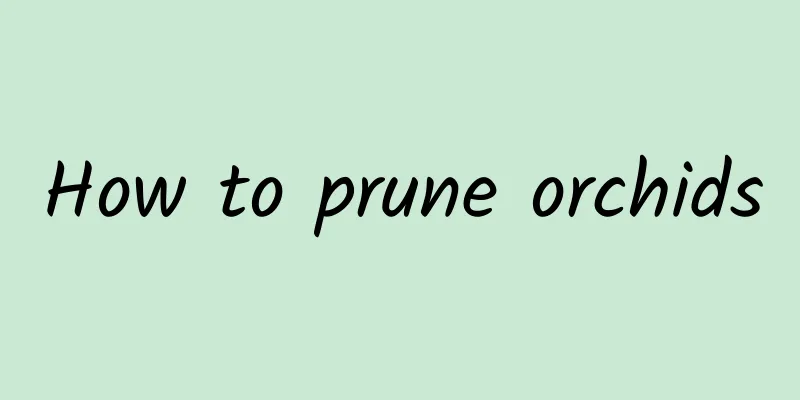How to prune orchids

When to prune orchidsIn fact, there is no fixed time for pruning orchids. As long as you see that the orchid has too many leaves, or old or dead leaves appear, you can prune them in time. For cuttings of orchid branches after pruning, you can cut a section of branches with nodes, about ten centimeters long, keep the leaves on it, then spray fungicides such as carbendazim on the wound for disinfection, and place the branches in a cool place to dry. Insert the branches directly into the prepared soil, then compact the soil with your hands, and then water it thoroughly. The purpose of this is to provide sufficient moisture for the plant's later growth. How to prune orchidsWhen you see that the orchid has too many leaves, you need to prune them in time, mainly pruning some weak and old leaves to allow healthy leaves more space to grow and ensure that the plant has a good ventilation environment. If you see that the orchid has branches and leaves that grow too high, you need to trim them in time and trim off the parts above the overly long branches and leaves. However, be careful not to trim them too short, otherwise it will affect the beauty of the plant. Orchid pruning makes it grow fasterIf you want the orchid to grow fast, you should also pay attention to the pruning of flower buds during its growth process. If the plant grows too many flower buds, you should cut them off. It is recommended to leave about 2 flower buds, and after the flowers bloom, the flower stems should be cut off in time. Orchid pruning and floweringIf you want the orchid to bloom, it also needs to be pruned properly. The old, dead and yellow leaves of the plant should be cut off. This not only allows ventilation but also reduces nutrient consumption. If you see that the tips of the orchid leaves are dry, they should also be cut off. Leaves damaged by pests and diseases should also be cut off to avoid infection. Orchid pruning precautionsThe roots of orchids are fleshy roots, which are very easy to rot if infected by bacteria. Therefore, when pruning the roots, you must pay attention to disinfecting the scissors. At the same time, you must also properly disinfect the roots to avoid wound infection. It is best to cut at an angle so that the wound is relatively flat. |
<<: Can an orange tree be planted outside your home?
>>: Can Zephyranthes be planted in the ground?
Recommend
How to grow gardenia in winter
Wintering tips temperature Gardenia doesn't l...
What are the cultivation methods and precautions for roses?
Rose cultivation method Rose is a plant of the Ro...
What are the benefits of growing maidenhair fern at home
The maidenhair fern is pleasing to the eye and is...
Why do succulents turn black in winter?
The reason why succulents will rot in winter Blac...
Where is the best place to plant prickly pear?
Where the prickly pear is planted Generally, sea ...
Can camellia be sprayed with potassium dihydrogen phosphate when it has flower buds? How to apply potassium dihydrogen phosphate to camellia
Potassium dihydrogen phosphate can improve camell...
New method for high-yield sweet potato cultivation New technology for high-yield sweet potato cultivation and management yield
High-yield sweet potato cultivation is a cultivat...
How to deal with hibiscus after it blooms
Hibiscus Flowering Post-Processing 1. Pruning Aft...
Cutting propagation of Sedum rotundifolia
Prepare This method of propagation allows the pla...
How to plant baby's breath seeds
How to sow baby's breath Choose loose soil In...
What to do if Clivia has too many roots
1. Not blooming Because the plant has not yet blo...
An expert in flower growing revealed that you should not place flowers in these “3” places, otherwise their leaves will always turn yellow and they will not grow tall!
1. Next to the heater It is winter now, and becau...
Don’t be afraid of Clivia being “pinched arrow”. Do these things and the flowers will bloom, stiff and the leaves will be green!
Do you know now? Observe the Clivia at home. If i...
What flowers are suitable for growing in Hulunbuir? What are the city flowers and trees?
1. Climate characteristics of Hulunbuir Hulunbuir...
When is the best time to harvest sorghum?
Sorghum is one of the important grain crops in my...









